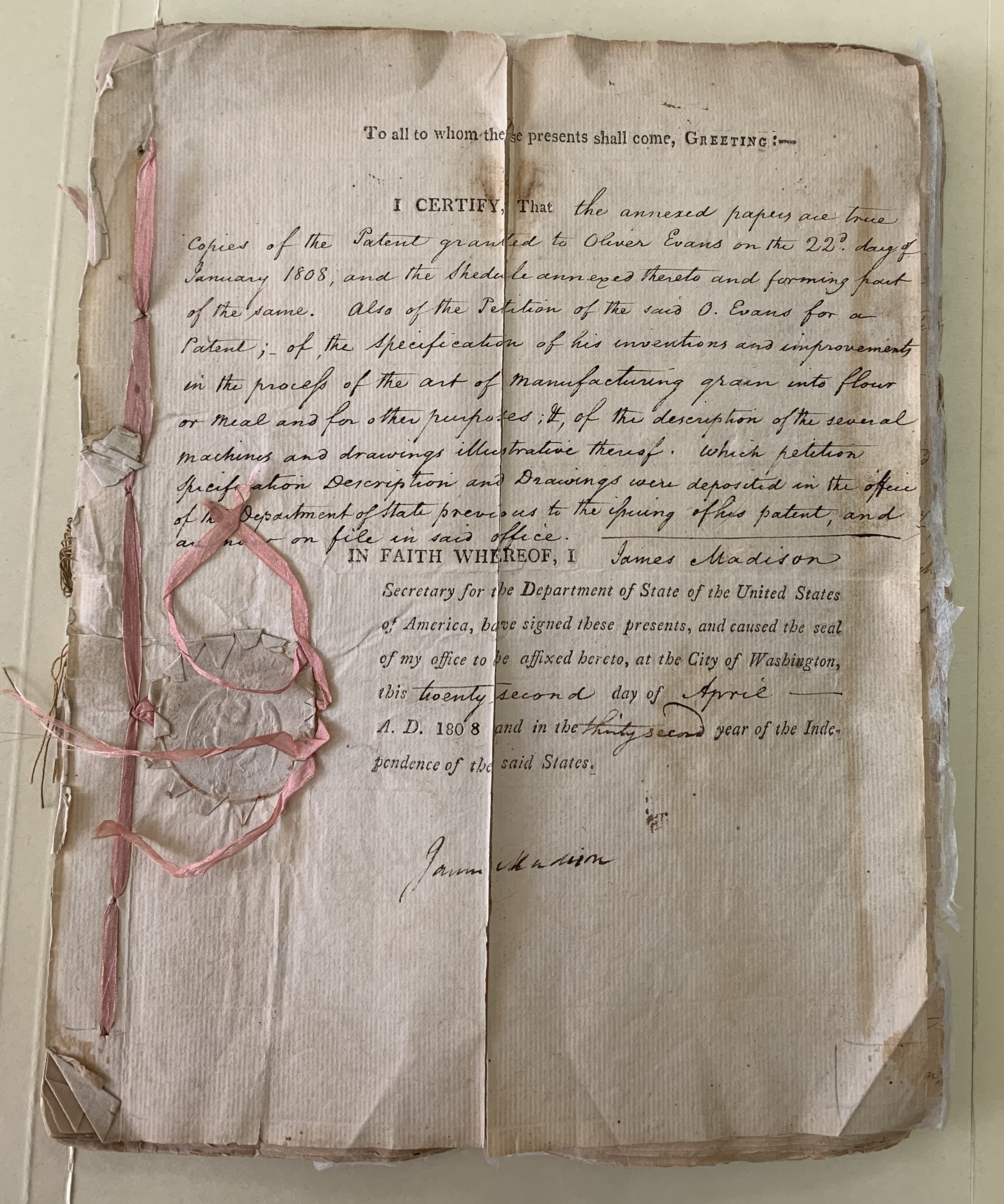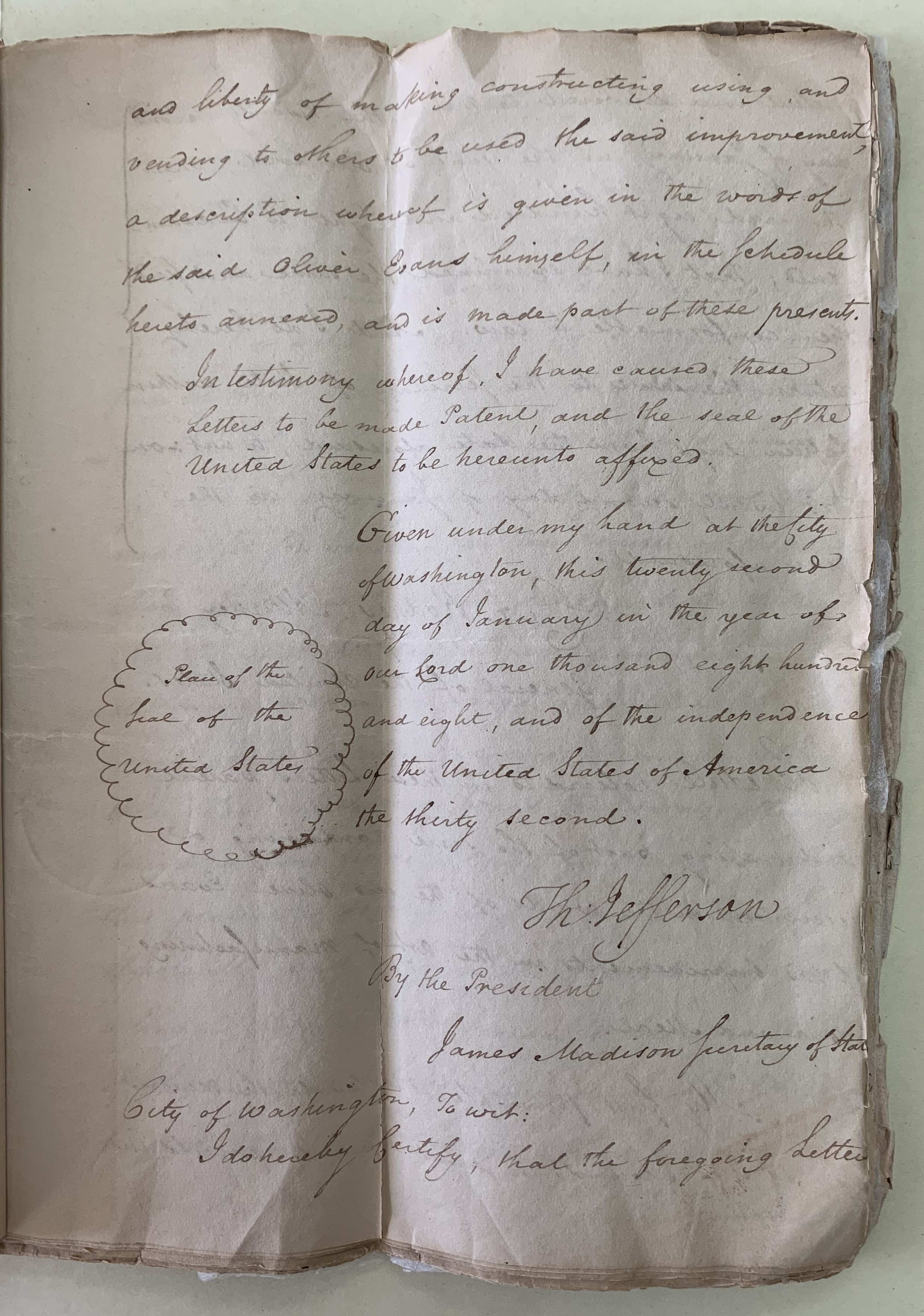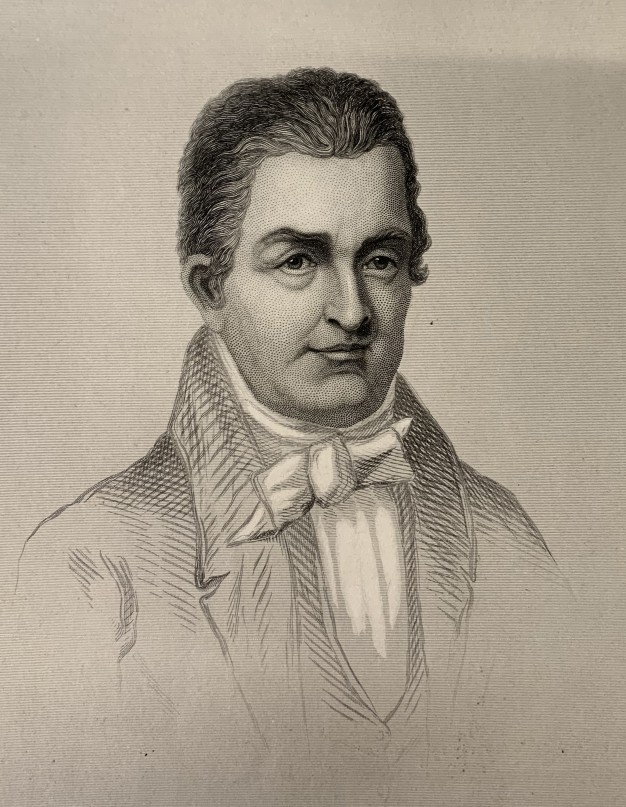Path of Vexation and Ruin Traversed by Oliver Evans, Until…
Oliver Evans engraving, APS Print Collection: Persons (EY 12.02). APS.
Oliver Evans (1755-1819) was born in Delaware, and became a prolific inventor. One of his inventions was an automated continuous production flour and meal mill, to be powered by water rather than manual labor. As he said, “I recollected to have seen a drawing of a chain pump for raising water from the holds of ships…I conceived the idea of attaching the buckets to one side of a leather strap, and making separate cases of boards for the ascending and descending parts of the endless strap, to prevent waste. I instantly saw with great joy and delight, that I had discovered the principle which might be applied to raise both grain and meal, and convey either in any direction or angle, ascending or descending…I intended building a flour mill, which should take the grain from the wagon, and carry it through all the operations necessary to manufacture it into superfine flour, itc, without the aid of manual labor in the attendance; but no person would believe it possible to be done….”

Evans had state patents procured in the 1780s for his automated mill, and although it was already built and running, Evans still faced the problem that millers couldn’t fathom such a thing being possible. However, in 1789, he was able to take advantage of an opportunity that he described this way: ”when superintending the mill...I observed two of the Brandywine millers coming to view the mill. I pretended not to see them, preferring their going into the mill and not finding any person there, so that by seeing every operation performed by machinery alone more perfectly than it was possible to be by the hand of man, they would be fully convinced of its utility.”
At the same time, the Constitution became the official framework of the United States government. With this, Article 1 Section 8, Clause 8, the Patent and Copyright Clause stating “Congress shall have the power…To promote the progress of science and useful arts, by securing for limited times to authors and inventors the exclusive right to their respective writings and discoveries,” was approved. Evans decided to apply for a patent under the U.S. Patent Act of 1790, and received U.S. Patent 3, Manufacturing Flour and Meal, on December 18th of that year. With the receipt of a U.S. patent, he was required to relinquish his state patents.
The Patent Act was meant to provide incentives for innovation, technology, and manufacturing. In reality, however, Evans received little compensation because people didn’t take out licenses. In an effort to justify compensation for patentees, he decided to write Mill-Write and Millers Guide to include Thomas Ellicott’s The Practical Mill Wright with draughts between 1793-1795, where he described and illustrated his invention in detail.


Still, people didn’t take out licenses, so in 1807 he sought a remedy against scofflaws in the Circuit Court of PA (Evans v. Chambers). Unfortunately for Evans, the court ruled against him, declaring his patent invalid, null and void. Recounting later, in a fit of pique “he collected, bound, and sealed in a bundle all the drawings, specifications, explanation and minutes of his inventions, not yet in use…apprehending that these papers might lead his children or grandchildren into the same path of vexation, and ruin, which he had traversed, and subject them to the same persecution which had so long paralyzed his efforts, he assembled his family, and stated to them, that the expense of time, labor, and thought, which the contents of these papers had cost him, was the true reason why he owned no property, notwithstanding his known economy, and indefatigable industry…They all burst into tears, and unanimously urged him to burn them. Without hesitation he acquiesced in this request, and committed his papers to the flames.”
In spite of his extreme frustration, Evans didn’t give up, and in January of 1808, he sought relief from Congress. The evidence of this effort can be examined in the manuscript below, An Act for the Relief of Oliver Evans, directing the Secretary of State to grant him a good patent for his improvements in the art of manufacturing flour and meal. The manuscript includes descriptions and illustrations of U.S. Patent 3 with improvements.

With improvements of U.S. Patent 3, An Act for the Relief of Oliver Evans, resulted in U.S. Patent 817, Mode of manufacturing flour and meal, and was granted to Oliver Evans on April 22, 1808 by Act of Congress.

An Act for the Relief of Oliver Evans specified: “for the term of fourteen years, the full and exclusive right and liberty of making, constructing, using, and vending to others to be used, his said improvement; and also of making, constructing, using, &c. all the machines, viz. his improved elevator, his improved conveyer, his improved hopperboy, his improved drill, and his improved kiln drier.”
Patents that were housed in the patent office between 1790-1836 in Washington D.C. were lost in a catastrophic fire in 1836. Due to this fire, patents from this time are known as the ‘X patents’ (3X and 817X, accordingly), because they predate the numbering system now in use.
For much of his adult life, Evans pressed for patent rights to be refined so that inventors could benefit from their inventions, also anticipating those who critiqued patents that, “Those who are inimical to patent rights, and wish to oppose them, call them monopolies, to make them odious to the people. This is a mere perversion of the term. A monopoly deprives the people of the use or benefit of something that they have possessed or used in their own, or common right, before the grant. But they cannot have possessed or used in their own, or common right, any thing that never did exist, or was unknown to them.”
The manuscript, An act for the relief of Oliver Evans, highlighted in this blog, includes a description of each of Oliver Evans’ machines that together automated the flour mill. Improvements to his original designs are included as well as sketches added to prints, such as the air hole for the kiln to dry the meal.


Resources:
PAM Vol 720, no.1, Address to Friends of American Manufactures, Tench Cox,1787, APS
The Young Mill-Wright and Miller’s Guide, Oliver Evans and Thomas Ellicott 1795
APS Archives III, Evans, Oliver
PAM Vol. 801, no.17, Oliver Evans to his council, APS
PAM Vol. 556, No. 6, Exposition of part of patent law, Oliver Evans, 1816, APS
PAM Vol. 720, no.12 Letter from the Secretary of State, list of patents 1790-1805, 1805.
PAM Vol. 720, no. 8 Plan of PA Society for the Encouragement of Manufactures and the Useful Arts. 1787, APS
PAM Vol. 1137, no. 9 Memorial of Oliver Evans to Congress
630 PAM, No. 135 Digest of Patents, Henry Leavitt Ellsworth
McCulloch Papers Mss. BM139, APS

